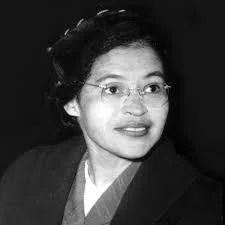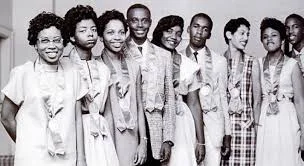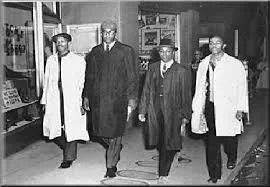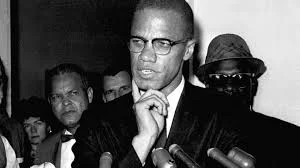-
 Separate but equal was not equal, white people's schools had better resources while black people had worse resources. In 1952 the NAACP brought cases that proved the black student schools were not equal. May 17 1954 the super court 9-0 declared that separate but equal was unconstitutional.
Separate but equal was not equal, white people's schools had better resources while black people had worse resources. In 1952 the NAACP brought cases that proved the black student schools were not equal. May 17 1954 the super court 9-0 declared that separate but equal was unconstitutional. -
 The murder of Emmet Till took place on August 28, 1955, in Money, Mississippi. Emmett Till, a 14-years-old African American boy from Chicago, was visiting relatives in Mississippi when he was accused of offending a white woman, a few days later, her husband and his half brother kidnapped him and tortured him and then they throw him to the Tallahatchie River. A few days later his body was found and his mother held an open casket funeral to expose the brutality of his murder.
The murder of Emmet Till took place on August 28, 1955, in Money, Mississippi. Emmett Till, a 14-years-old African American boy from Chicago, was visiting relatives in Mississippi when he was accused of offending a white woman, a few days later, her husband and his half brother kidnapped him and tortured him and then they throw him to the Tallahatchie River. A few days later his body was found and his mother held an open casket funeral to expose the brutality of his murder. -
 On December 1, 1955, Rosa Parks boarded a bus in Montgomery, Alabama. Instead of going to the back of the bus, which was designated for African Americans, she sat in the front.
On December 1, 1955, Rosa Parks boarded a bus in Montgomery, Alabama. Instead of going to the back of the bus, which was designated for African Americans, she sat in the front. -
 The SCLC was an organization linked to the black churches. 60 black ministers were pivotal in organizing civil right activism. Martin Luther King Jr was elected President. They focused its non violent strategy on citizenship, schools and efforts to desegregate individual cities, It played key roles in the March on Washington in 1963 and the Voting Rights Campaign and March to Montgomery in 1965.
The SCLC was an organization linked to the black churches. 60 black ministers were pivotal in organizing civil right activism. Martin Luther King Jr was elected President. They focused its non violent strategy on citizenship, schools and efforts to desegregate individual cities, It played key roles in the March on Washington in 1963 and the Voting Rights Campaign and March to Montgomery in 1965. -
 The Little Rock Nine were a group of nine African American students enrolled in Little Rock Central High School in 1957. Their enrollment was followed by the Little Rock Crisis, in which the students were initially prevented from entering the racially segregated school by Orval Faubus, the Governor of Arkansas.
The Little Rock Nine were a group of nine African American students enrolled in Little Rock Central High School in 1957. Their enrollment was followed by the Little Rock Crisis, in which the students were initially prevented from entering the racially segregated school by Orval Faubus, the Governor of Arkansas. -
 The Greensboro Sit-ins were led by four Black college students-Ezell Blair Jr., David Richmond, Franklin McCain, and Joseph McNeil-on February 1, 1960, at a Woolworth's lunch counter in Greensboro, North Carolina. They protested racial segregation by sitting at the "whites-only" counter.
The Greensboro Sit-ins were led by four Black college students-Ezell Blair Jr., David Richmond, Franklin McCain, and Joseph McNeil-on February 1, 1960, at a Woolworth's lunch counter in Greensboro, North Carolina. They protested racial segregation by sitting at the "whites-only" counter.
Their actions sparked a wave of sit-ins across the -
 Ruby Bridges has always been a civil rights advocate, with her experience as the first Black child to enter an all-white school in the South making her a household name. Though her experience in school was harrowing due to blatant racism and the targeting of her family, Bridges never missed a day of school. Presently, the Ruby Bridges Foundation and Bridges herself continue to host speaking engagements and write children’s books to strive for an end to racism in America.
Ruby Bridges has always been a civil rights advocate, with her experience as the first Black child to enter an all-white school in the South making her a household name. Though her experience in school was harrowing due to blatant racism and the targeting of her family, Bridges never missed a day of school. Presently, the Ruby Bridges Foundation and Bridges herself continue to host speaking engagements and write children’s books to strive for an end to racism in America. -
 Fifty years ago, seven black people boarded buses with six white people in Washington, D.C., and took the fight for civil rights to the Deep South. Their trip became known as the Freedom Rides. In Freedom Riders, a new documentary that airs this month on PBS, filmmaker Stanley Nelson talks with the people who witnessed the rides, which were organized by the Congress of Racial Equality.
Fifty years ago, seven black people boarded buses with six white people in Washington, D.C., and took the fight for civil rights to the Deep South. Their trip became known as the Freedom Rides. In Freedom Riders, a new documentary that airs this month on PBS, filmmaker Stanley Nelson talks with the people who witnessed the rides, which were organized by the Congress of Racial Equality. -
 On 28 August 1963, more than 200,000 demonstrators took part in the March on Washington for Jobs and Freedom in the nation’s capital. The march was successful in pressuring the administration of John F. Kennedy to initiate a strong federal civil rights bill in Congress. During this event, Martin Luther King delivered his memorable “I Have a Dream” speech.
On 28 August 1963, more than 200,000 demonstrators took part in the March on Washington for Jobs and Freedom in the nation’s capital. The march was successful in pressuring the administration of John F. Kennedy to initiate a strong federal civil rights bill in Congress. During this event, Martin Luther King delivered his memorable “I Have a Dream” speech. -
 In a nationally televised address on June 6, 1963, President John F. Kennedy urged the nation to take action toward guaranteeing equal treatment of every American regardless of race. Soon after, Kennedy proposed that Congress consider civil rights legislation that would address voting rights, public accommodations, school desegregation, nondiscrimination in federally assisted programs, and more
In a nationally televised address on June 6, 1963, President John F. Kennedy urged the nation to take action toward guaranteeing equal treatment of every American regardless of race. Soon after, Kennedy proposed that Congress consider civil rights legislation that would address voting rights, public accommodations, school desegregation, nondiscrimination in federally assisted programs, and more -
 Malcolm X was killed in 1965 when three armed men shot him 21 times as he was preparing to speak in New York. The lawsuit alleges that a “corrupt, unlawful and unconstitutional” relationship between law enforcement and the “ruthless killers” allowed for the murder
Malcolm X was killed in 1965 when three armed men shot him 21 times as he was preparing to speak in New York. The lawsuit alleges that a “corrupt, unlawful and unconstitutional” relationship between law enforcement and the “ruthless killers” allowed for the murder -
 On 2 January 1965 King and SCLC joined SNCC, the Dallas County Voters League, and other local African American activists in a voting rights campaign in Selma where, in spite of repeated registration attempts by local blacks, only two percent were on the voting rolls.
On 2 January 1965 King and SCLC joined SNCC, the Dallas County Voters League, and other local African American activists in a voting rights campaign in Selma where, in spite of repeated registration attempts by local blacks, only two percent were on the voting rolls. -
 White men, age 21 and older, who owned property were given the right to vote in 1776. The 15th Amendment to the Constitution removed racial barriers to voting in 1870, but states continued to practice voter discrimination and continued to deny Black voters a chance to participate in elections. The right to vote was extended to white women in 1920.
White men, age 21 and older, who owned property were given the right to vote in 1776. The 15th Amendment to the Constitution removed racial barriers to voting in 1870, but states continued to practice voter discrimination and continued to deny Black voters a chance to participate in elections. The right to vote was extended to white women in 1920. -
 At 6:05 P.M. on Thursday, 4 April 1968, Martin Luther King was shot dead while standing on a balcony outside his second-floor room at the Lorraine Motel in Memphis, Tennessee. News of King's assassination prompted major outbreaks of racial violence, resulting in more than 40 deaths nationwide and extensive property
At 6:05 P.M. on Thursday, 4 April 1968, Martin Luther King was shot dead while standing on a balcony outside his second-floor room at the Lorraine Motel in Memphis, Tennessee. News of King's assassination prompted major outbreaks of racial violence, resulting in more than 40 deaths nationwide and extensive property